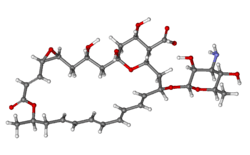Natamycin
 | |
 | |
| Names | |
|---|---|
| IUPAC name
(1R,3S,5R,7R,8E,12R,14E,16E,18E,20E,22R,24S,25R,26S)-22-[(3-amino-3,6-dideoxy-D-mannopyranosyl)oxy]-1,3,26-trihydroxy-12-methyl-10-oxo-6,11,28-trioxatricyclo[22.3.1.05,7]octacosa-8,14,16,18,20-pentaene-25-carboxylic acid | |
| Identifiers | |
| 7681-93-8 | |
| 3D model (Jmol) | Interactive image |
| ChEMBL | ChEMBL1200656 |
| ChemSpider | 10468784 |
| DrugBank | DB00826 |
| ECHA InfoCard | 100.028.803 |
| E number | E235 (preservatives) |
| KEGG | C08073 |
| PubChem | 441382 |
| UNII | 8O0C852CPO |
| |
| |
| Properties | |
| C33H47NO13 | |
| Molar mass | 665.725 g/mol |
| Appearance | White to cream-colored crystalline powder |
| Density | 1.35 g/ml |
| Melting point | Darkens at ±200 °C with vigorous decomposition at 280-300 °C |
| 0.39 mg/ml | |
| Pharmacology | |
| A01AB10 (WHO) A07AA03 (WHO), D01AA02 (WHO), G01AA02 (WHO), S01AA10 (WHO) | |
| Except where otherwise noted, data are given for materials in their standard state (at 25 °C [77 °F], 100 kPa). | |
| | |
| Infobox references | |
Natamycin (INN), also known as pimaricin and sometimes sold as Natacyn, is a naturally occurring antifungal agent produced during fermentation by the bacterium Streptomyces natalensis, commonly found in soil. Natamycin has a very low solubility in water; however, natamycin is effective at very low levels. Its minimum inhibitory concentration is less than 10 ppm for most molds. Natamycin is classified as a macrolide polyene antifungal, and as a drug, is used to treat fungal keratitis, an infection of the eye. It is especially effective against Aspergillus and Fusarium corneal infections. Other common members of the polyene macrolide antifungal family are amphotericin B, nystatin, and filipin. Natamycin is also used in the food industry as a natural preservative.
Uses
In foods
Natamycin has been used for decades in the food industry as a hurdle to fungal outgrowth in dairy products and other foods. Potential advantages for the usage of natamycin might include the replacement of traditional chemical preservatives, a neutral flavor impact, and less dependence on pH for efficacy, as is common with chemical preservatives. It can be applied in a variety of ways: as an aqueous suspension (such as mixed into a brine) sprayed on the product or into which the product is dipped, or in powdered form (along with an anticaking agent such as cellulose) sprinkled on or mixed into the product. While not currently approved for use on meats in the United States, some countries allow natamycin to be applied to the surface of dry and fermented sausages to prevent mold growth on the casing. Also, natamycin is approved for various dairy applications in the United States. More specifically, natamycin is commonly used in products such as cottage cheese, sour cream, yogurt, shredded cheeses, cheese slices, and packaged salad mixes. One of the reasons for food producers to use natamycin is to replace the artificial preservative sorbic acid.[1]
As a food additive, it has E number E235. Throughout the European Union, it is only approved as a surface preservative for certain cheese and dried sausage products. It must not be detectable 5 mm below the rind. While natamycin is approved in different applications at different levels in the world, it is approved in over 150 countries worldwide.[2]
The European Food Safety Authority (EFSA) panel took over the responsibilities of providing scientific food safety advice to the EU from the Scientific Committee on Food in 2002.[3] In 2009, the EFSA considered the proposed use levels of natamycin are safe if it is used for the surface treatment for these cheese and sausages types.[4]
Medical
Natamycin is used to treat fungal infections, including Candida, Aspergillus, Cephalosporium, Fusarium, and Penicillium. It is applied topically as a cream, in eye drops, or (for oral infections) in a lozenge. Natamycin shows negligible absorption into the body when administered in these ways. When taken orally, little or none is absorbed from the gastrointestinal tract, making it inappropriate for systemic infections.[5] Natamycin lozenges are also prescribed to treat yeast infections and oral thrush. [6]
Mechanism of Action
Natamcyin is able to inhibit growth of fungi by inhibiting transport of amino acids and glucose across the plasma membrane. Natamycin performs this function by specifically binding to ergosterol and inhibiting membrane transport proteins.[7]
History
Natamycin was first isolated in 1955 from fermentation broth of a Streptomyces natalensis cell culture. The discovery and properties of natamycin where announced in the article, “Pimaricin, a new antifungal antibiotic” in Antibiotics Annual in 1957. [8]
Natamycin was originally named pimaricin to honor Pietermartizburg, where Streptomyces natalensis was acquired. Pimaricin was later renamed natamycin after the World Health Organization (WHO) mandated that antibiotics produced by Streptomyces end in –mycin. The name also related to the organism producing the compound, Streptomyces natalensis, hence the name natamycin. [8]
Safety
Natamycin does not have acute toxicity. In animal studies, the lowest LD50 found was 2.5-4.5 mg/kg.[9] In rats, the LD50 is ≥2300 mg/kg, and doses of 500 mg/kg/day over 2 years caused no detectable differences in survival rate, growth, or incidence of tumors. The metabolites of natamycin also lack toxicity. The breakdown products of natamycin under various storage conditions may have a lower LD50 than natamycin, but in all cases, the numbers are quite high. In humans, a dose of 500 mg/kg/day repeated over multiple days caused nausea, vomiting, and diarrhea.[10]
No evidence shows natamycin, at either pharmacological levels or levels encountered as a food additive, can harm normal intestinal flora, but definitive research may not be available.[10] However, some people are very allergic to natamycin. [11]
The EFSA has concluded that the use of natamycin as a food additive has no relevant risk for the development of resistant fungi.
Natamycin appears on Whole Foods “Unacceptable Ingredients for Food” list.[12]
External links
References
- ↑ Kraft cheese singles ditch artificial preservatives
- ↑ Regulatory information: www.natamycin.com
- ↑ Safety and regulation: the formal process for analyzing the test data on food additives
- ↑ Scientific Opinion on the use of natamycin (E 235) as a food additive
- ↑ Sweetman, S. (2004). Martindale: The Complete Drug Reference
- ↑ Virginia-Maryland Regional College of Veterinary Medicine (http://cpharm.vetmed.vt.edu/VM8784/antimicrobials/Classes/antifungals.cfm)
- ↑ te Welscher, Y. M.; van Leeuwen, M. R.; de Kruijff, B.; Dijksterhuis, J.; Breukink, E. Polyene antibiotic that inhibits membrane transport proteins. Proc. Natl. Acad. Sci. U. S. A. 2012, 109, 11156-11159.
- 1 2 Natamycin VGP (http://www.natamycinvgp.com/the-origins-of-natamycin/#prettyPhoto)
- ↑ Oostendorp, J.G. (1981). "Natamysin(R)". Antonie van Leeuwenhoek. 47: 170–1. doi:10.1007/bf02342201.
- 1 2 Mattia, A. et al. Safety evaluation of certain food additives and contaminants: natamicin (pimaricin). WHO Food Additives Series #48.
- ↑ Natacyn Side Effects Center
- ↑ Unacceptable Ingredients for Food (http://www.wholefoodsmarket.com/about-our-products/quality-standards/food-ingredient)